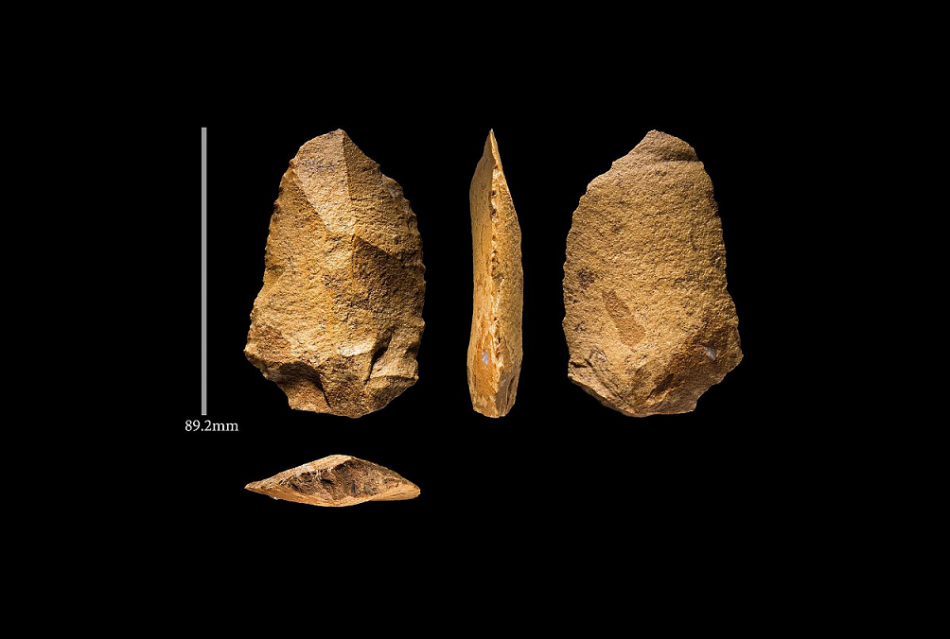Discover evidence of human migrations from Africa to the Arabian Peninsula 400,000 years ago

RIYADH - The Saudi Heritage Authority announced recent archaeological discoveries in the north of the Kingdom that show evidence of early human migrations from Africa to the Arabian Peninsula that began about 400,000 years ago and was repeated in multiple time stages during 300,000, 200,000, 130-75 thousand and 55 thousand years ago. , as the longest civilized record of the early human presence in the Arabian Peninsula, which confirms the civilizational importance of the Arabian Peninsula and the role in which human groups contributed to a number of civilizational developments outside the continent of Africa.
The authority explained that the Saudi international mission, in which specialists from the Heritage Authority, the Max Planck Institute in Germany, and King Saud University, in addition to a number of distinguished international universities and centers, found the remains of stone tools and fossilized animal bones, found within the layers of dry lakes in the Nafud desert, northwest of the Kingdom of Saudi Arabia. Saudi Arabia. At the site of Khel Amishan, on the outskirts of the Tabuk region, antiquities dating back about 400,000 years were found, including Acheulean axes, which are considered the oldest dated archaeological remains in the Arabian Peninsula.
Nature, the world's most famous magazine in the field of publishing scientific research related to archeology, published today, Wednesday, September 1, a study that examined the history of a number of layers of sediment for the ancient lakes at the sites of Jubbah and Khel Amishan at Nafud al-Kabir, which represent rainy periods experienced by the Arabian Peninsula. The study revealed that the various stages of human existence were characterized by archaeological remains whose characteristics and characteristics differ in each of their periods, which indicates the difference of these groups from each other and the emergence of new stone industries according to the time period.
The study contributed to determining the time periods with a temperate climate during which these human migrations took place from Africa to the Arabian Peninsula, despite the absence of cave deposits that usually retain such cultural significance.
The scientific study showed the existence of Acheulean stone industries dating back 200,000 years, which are relatively recent compared to their counterparts in southwest Asia, which indicates the cultural peculiarity of the Arabian Peninsula and its cultural features shaped by the environmental and cultural conditions prevailing at the time. Stone tools, rather than as living sites for human groups.
The site of Khel Amishan in Nafud on the outskirts of the Tabuk region is considered one of the unique archaeological sites on the level of the Arabian Peninsula, because it contains several archaeological layers, which include environmental information from different periods.
The early archaeological layer at the site of Khel Amishan, which dates back to about 400,000 years, included Acheulean axes, and is the oldest dated archaeological remains in the Arabian Peninsula. The layer above it includes stone axes characterized by their small size, and their age dates back to about 300,000 years ago.
Above the layer is stone tools that were absent from axes, and it showed the first indications of the manufacturing technique known as Levloisia, which was dated to 200,000 years ago. Then there are two archaeological layers, the oldest of which are dated to between 125-75 thousand years ago, and the newest layer to about 55 thousand years ago; And the two layers were distinguished by a distinctive levloise technique.
The Acheulean civilization continued until the humid periods of the late Middle Pleistocene era, which was contemporaneous with the Levulusian industry technology at the end of the Acheulean civilization period. These stone industries are unique in their technical advantages and are not similar to their counterparts in the eastern Mediterranean. The study showed that the levlouis industry in Al-Nafud Al-Kabeer is closer in its cultural characteristics to its counterparts in East Africa.
The study of animal skeletal remains showed the presence of hippopotamus and other bovine bones over multiple time periods, which confirms the existence of an environment rich in water bodies and dense vegetation in the north of the Arabian Peninsula; This corresponds to a large extent with the prevailing climatic conditions in North Africa.
The research team was able to identify five waves of human migrations to the Arabian Peninsula from Africa, which were associated with improved climatic conditions and reduced drought.
The discovered stone industries, two of which date back to the Acheulean civilization and the other three to the Middle Paleolithic period, showed a technical discrepancy confirming the difference of these human groups from each other.
The scientific team also presented the results of the archaeological study of the Jubbah site in the Hail region, which is an ancient lake that contained archaeological layers similar to what was found at the site of Khel Amishan. This study provided us with information about the climatic conditions experienced by the region in prehistoric times.
The scientific study relied on the latest technologies and distinguished scientific methods to reach accurate and confirmed information about the civilizational history of human groups in the Arabian Peninsula, on which a research team from a number of international and national centers and universities was based. Attached to this study is a detailed appendix of all the office, laboratory and field procedures and studies in more than 120 pages.



